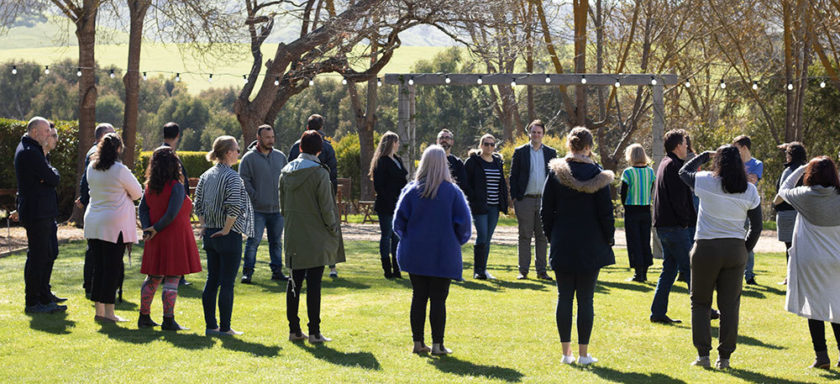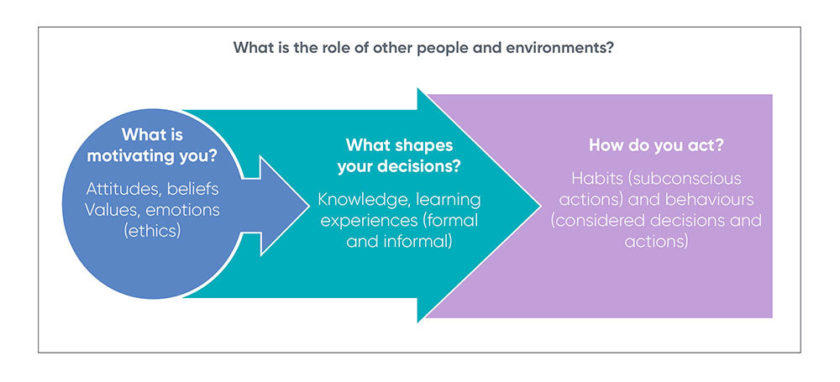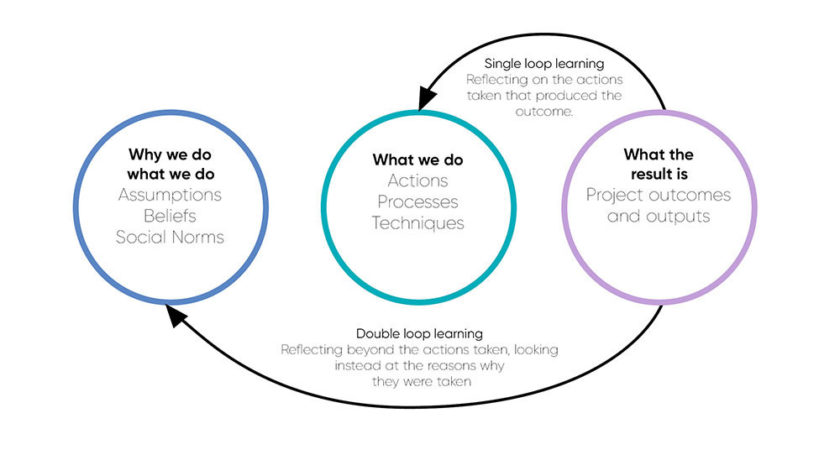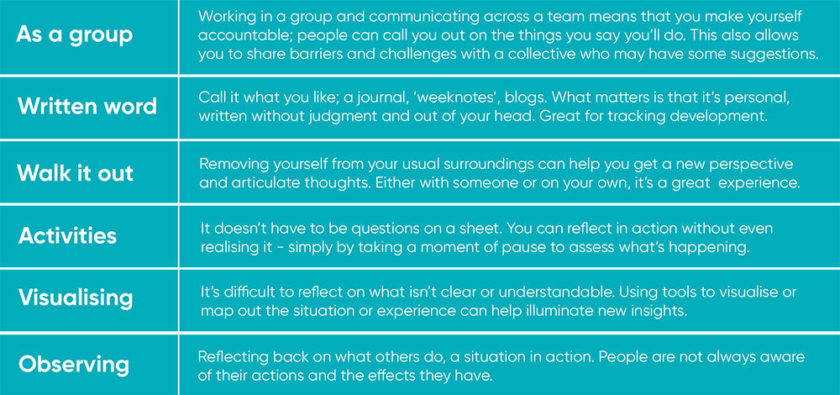We believe that a habit of reflection can increase the innovation capacity of public sector workers.
In this blog, we discuss how reflection can help us better understand our actions and behaviours, what type of activities we can undertake to help us reflect effectively, and what we've learned from doing these on the States of Change learning programmes.
How we embed innovation in governments is changing. Where we once mainly focussed on specific ‘innovation’ projects, we can now see a shift instead to how individuals and teams can work in new, more innovative ways, and ensuring they have the innovation capacity to do this.
There are broader questions around what this ‘innovation capacity’ is, however, and when we developed our Competency framework with innovation practice leaders ‘being reflective’ was identified as a core attitude.
What do we mean by ‘being reflective’?
Reflection has long been associated with learning, in fact, there’s a well established literature on this. Numerous models build upon the idea that reflection is thinking about past and current situations and experiences to make sense of them, and inform future choices. To make better ones, you’d hope. It’s a key element in the reflection cycles of Kolb, Gibb, Argyris and Schon (The Reflective Practitioner, 1984).
There’s also a range of blogs (and literature) that discuss the importance of reflection in innovation; but less which look explicitly at public sector innovation. There is little on the supporting tools and structures that enable innovation teams to develop a habit of reflection.
And we’re not sure what this means for solving problems in an experimental way in government.
“There is little on the supporting tools and structures that enable innovation teams to develop a habit of reflection.”
We also lack an understanding of the potential importance, and methods for, eliciting a deeper reflection. In what ways can we go beyond reflecting upon just our actions, and into our motivations, emotions, beliefs and cognitive biases - the architecture underlying our behaviours? Because these are important too.
Using reflection to reveal our underlying motivations
Our motivations rely on our formative years; our norms, cultures, morals of right and wrong. These inform our attitudes to others, to situations, to what we’ll pay attention to. These motivating factors shape what we are willing to learn and also how we understand. It provides a lens through which we make sense of the world.
These understandings and motivators become evident in our actions and behaviours (whether habitual, or considered). Each of these levels are influenced by other people and environments dictating the social norms in which we operate, from home to school, to early careers.
“These understandings and motivators become evident in our actions and behaviours (whether habitual, or considered).”
Think of yourself as a snowball rolling downhill, growing in size, collecting experiences and sense-making processes as you travel through life. By the time you’ve reached a senior level within an institution, you’ve experienced lots and realised which actions worked and which didn’t.
By now you’re a massive snowball powered by a weight of experience. And this often works in our favour. Until it doesn’t. Our previous successes can limit our willingness and ability to try new approaches. You end up a snowball that’s grown so large that you can only roll in one direction. So how do you change course when you need to?
Reflecting helps to solve the big problems (and the small)
The value of reflecting goes bigger than individual projects or process. It ignites a discussion around organisational culture as well as individual behaviour, questioning the assumptions and beliefs that drive the status quo.
When you reflect, you question yourself, others, the processes, the systems - this seeding of doubt can lead to alternatives, by eliciting the ‘what if’ questions fundamental to experimentation.
Which is where we want government to get to: comfortable with experimental problem solving. The premise behind experimental problem solving is just that - experimentation. A systematic approach of exploring multiple ideas, testing a hypothesis and demonstrating which approaches and solutions show the most promise. This requires continuous reflection: explore - reflect. Ideate - reflect. Test - reflect. Iterate - reflect. And so on.
Why reflection is trickier in government
Traditional governments do not necessarily have an experimental culture, nor do they foster an experimental approach. Governments are very good at managing risks but are less comfortable in dealing with uncertainty (or failure). They are designed to plan policies and systems for the future, which means they are often poorly set up to acknowledge what they don't know.
Accelerating learning around these unknowns or when dealing with ‘wicked problems’ often requires trying something new and learning from failure. But when even failure at small scale is viewed negatively, it prevents governments and their employees feeling comfortable in trying new things.
The failures of individuals are under constant scrutiny in this area of work; you have to be seen to deliver value for money for citizens. It’s difficult to justify through quantifiable means that reflection isn’t ‘wasted time’, but an investment.
Why reflection sometimes gets a bad wrap
Reflection is often seen as a ‘soft’ activity, in which people self indulgently speak about their thoughts and emotions, or worse: navel gaze. But when done effectively, this couldn't be further from the truth. Holding a metaphorical mirror up to yourself (or your organisation) is difficult. Interrogating what you’ve done, why and how to improve on it is by no means the easy option. Doing things exactly the same as before and hoping it works next time? That’s the easy choice.
Without positive role models or support structures in an organisation, the environment for reflection is hard enough. But throw in a common culture that sees identifying possible faults and shortcomings as a kamikaze career move and it's no wonder that it’s at the bottom of many people's ‘to-do’ list.
"Interrogating what you’ve done, why and how to improve on it is by no means the easy option. Doing things exactly the same as before and hoping it works next time? That’s the easy choice."
There are also misconceptions around reflecting that reduce it to an arduous or uncomfortable set of questions - neither of which you have either the time for or the capacity to answer. This leaves people unsure how their reflection has helped; instead leaving them very aware of issues they are none-the-wiser on.
It’s easy to end up frustrated with a process that’s made your life seemingly harder, and uncertain in your ability to do their job well. Reflecting in this way often leads people to a bad case of imposter syndrome. Even if you pick up on some key element you’d like to work on, the situational or organisational barriers might feel like insurmountable obstacle preventing you from getting on with it. Either way, it’s frustrating and counter-productive.
When and how to reflect
Reflection shouldn’t be a one-off activity, it’s cyclical: you act, then reflect, sense make, then act again and so on. Our approach is to encourage people to ‘be reflective’, not simply ‘to do reflection’ at different points. There’s no ‘right way’ to reflect. Here are a few examples to get you started:
Our key insights
We're still developing and testing our approaches (head to the end of the blog to read about the refllection activities we've been in our programmes). Here’s what we’ve learnt so far:
- It’s emotional. The number of public sector workers who identified self-doubt, lack of confidence, trouble dealing with uncertainty, and a lack of efficacy and agency as major barriers to their work demonstrates the need to address this area. If we are asking people to be comfortable holding onto uncertainty while still trying to experiment with untested ideas, we need to better support them in doing so.
- You need the space (physical and mental). A safe space is vital. You’re asking people to expose themselves, to be vulnerable, to talk about concerns and weaknesses. There should be no judgement attached to the reflection. Also a different physical space is important, whether it be a separate notebook or having reflection conversations while walking around the park. Changing the scenery and backdrop can prompt different conversations.
- Dedicate the time. Carve it out, be precious, be greedy, be protective and make the time. Because ultimately it will save time (and money?) down the track by not repeating behaviours or patterns that are no longer serving you.
- You can’t force it. There are certain prerequisites to doing reflection well. People need to be curious, have a commitment to self development and a humbleness about what they know. These qualities are needed to counter the defensiveness, habit and resistance that comes about with any change.
- Facilitation matters. Outsiders may be beneficial. Having someone external to your organisation appears to enable more open conversations (maybe they suffer fewer ramifications from asking tough - but important - questions?). Having a mix of facilitators appears useful. It demonstrates a range of styles and approaches to reflection and allows multiple people to bring their expertise and experiences into the mix, leading to more diverse conversations.
- Intensive working periods. Participants were able to build a rhythm of reflecting in the week-long learning sessions we had. This frequency led to a comfort with and trust of the process, and increase the level of vulnerability with each other and the faculty. We could challenge them, they could challenge us.
- It must be purposeful. Reflection can’t be done for the sake of it, it isn’t just a ‘nice to have’. There has to be a purpose and this purpose has to be explicit. There needs to be a degree of sense-making post-reflection, where answers to the all-important ‘what now’ questions are addressed. How do we support reflection into action?
- Varied is better. Reflection isn’t completing a form. It’s a conversation, an action, an observation, a singular confrontational question, a moment. It can happen alone, or in pairs, or in small groups. All are valid.
What challenges do we still face?
We learnt a great deal about supporting reflection across the Victoria, Canada and Colombia cohorts (see the end of the blog for more details on what we did), and we thank them for being so open to new approaches. But we’re still learning how to do this better, and our own reflections have raised several other challenges we’ll tackle moving forward.
- How to make this practice happen when we’re not around? We created spaces for reflection during our delivery, but we’re unsure of whether we have enabled our teams to create their own space to reflect once they return to daily work.
- How to move beyond saying what’s expected of you? Forms of self-assessment can often be ‘edited’ to look better. If you want to, it’s easy to game the system. What are the ways and means to better support honest and confronting reflections?
- What happens after reflection? What next? Does supporting people in reflecting lead to a change in habit and behaviours, or does this require further support and signposting? How can we begin to measure the impact? How can we ensure we are doing no harm in stimulating vulnerability?
- How to ensure the value is clear? We didn’t always successfully answer the ‘why are we doing this?’ question. There needs to be explicit dot joining on our side. At times participants didn’t see the connection between reflection, capabilities, behaviours and innovation practice.
What we’ve tried so far in our programmes
Reflection has been fundamental across the different States of Change learning programmes. Below is a runthrough of the structures, tools and facilitated activities designed to encourage individuals and teams to reflection.
States of Change Victoria, DPC - Exploring rhythm, rituals and space for reflection
We wanted to carve out the space and time for reflection for our participants. Part of allowing them to rehearse the habit of reflection came through the rhythm and ritual elements we established during our face-to-face learning sessions.
EQ Check-in: An ‘emotional check-in’ at the start of each day where each person shares their emotional presence as a percentage; 100% being ‘I’m feeling amazing’ and 0% being ‘I’m really struggling here’. Where you are depends on energy levels, whether you slept well, if you have other personal or work-related concerns taking up head space, etc. It provides the rest of the group with an expectation of your engagement and contribution. It also shifts conversations from practical talk to something more personal; strengthening trust, empathy and understanding between participants along the way.
Wrap up and reflection: This happened at the end of each day and involved discussing ‘ah-ha’ moments and challenges. This time was predominantly to reflect on the learning, and how it applied to the context of the cohort’s work and challenges, looking at how their assumptions were being challenged. It was time for what they’d learnt that day to sink in.
Critical to these activities was creating a feeling of safety for the participants. You can call a space ‘safe’, but just because you label it as such doesn’t make it so. It has to be nurtured and protected and we found success through these simple activities. Participants felt able to be vulnerable and talk about their uncertainties.
Colombia - Reflecting to shape the Lab’s purpose, alter ways of working and develop capabilities
Our time spent with Colombia’s Equipo de Innovación Pública (EiP) team was to support them in their role as a strategic change agent within the National Planning Department (DNP).
User manual: This tool supports teams to reflect on the ways they work together (adapted from Ivar Kroughrud). Each member of the EiP individually completed a user manual, responding to prompts such as ‘What does it look like when I work best? What does it look like when I need help?’. The team shared their responses, unearthing practical and emotional preferences (and issues) about the ways they work, ultimately making suggestions of new ways of working they could test moving forward.
Competency framework: This tool helped identify the skills and attitudes within the team. Each member mapped their five strongest skills, and three strongest attitudes, creating a heat map of the team's strengths and weaknesses. This became a prompt for the team to discuss the work they do, the effect of any ‘gaps’, areas they may potentially wish to develop, and it cast light on the underlying reasons why they operate the way they do.
Wheel of trade-offs: This was used to prompt reflection around decisions, compromises and pragmatic choices the team would need to make to survive. The team were asked to write out their concerns and needs for achieving their vision and mission. They then visualised where the multiple challenges lay in order to support discussion of how to overcome them. This highlighted where to accept the status quo and where to confront it.
These interventions focused on building reflective capacity and challenging assumptions the EiP had about each other, themselves, their potential and their limitations as a team. These activities transformed intangible concepts into visible representations they could interrogate.
Canada - Reflecting to change behaviours and develop capabilities
With the Government of Canada’s Entrepreneurs (GCEs), we explored how reflective activities could help identify habits and behaviours the participants wanted to change, what they wanted to change them to, and how to do that.
Using the skills and attitudes listed in the competency framework, participants completed a Changing Habits worksheet, in which they identified the habits they wished to do less of and the ‘experimental’ habits they wished to do more of.
We followed this up with one-to-one calls between us and the GCEs to discuss what they had written, suggesting ways they could achieve the behaviour change they were looking for. This was an attempt to support double-loop learning, where a GCE would identify a behaviour they wanted to change and think about why they took that action; what drove that decision, what assumptions or beliefs played a role? It was often a lack of confidence or self-belief in their own role and agency causing these issues.
Some participants found this activity useful, others less so. There was an element of ‘saying the right thing’ and the feeling that several GCEs were involved because it was something asked of them, not because they saw real value in it for their day-to-day work.
There was a slight push back around the approach, some participants didn’t see any use in identifying personal attributes they felt unable (and unnecessary) to change i.e. procrastination, introversion, disorganisation. The aim wasn’t to address these qualities, but to practice looking more closely at possible underlying causes, whether this had a negative effect on their work, and if it did, explore ways to counter them. The link between this and their daily practice needed to be made clear.




